Trekking through Nepal and Tibet
Saturday, 18 July 2009 Kathmandu, Bagmati, Nepal
Durbar Square
After ten uncomfortable hours trying, but failing, to sleep on a plane we found ourselves at Delhi airport we found ourselves with three hours wait. I had been waiting to go to Mount Kailash for five years but through a combination of work and politics had not managed it. On the work side the last two years had been very busy getting back up to speed in investment banks after an eight year break. I choose Lehman Brothersto make my return with the spectacular result that it collapsed in September 2008. However I had the good luck to be in part of the bank bought by Nomura and had been working furiously since then to build a new computer system. Having had no holidays since Christmas I decided that I desperately needed to unwind and with our project pretty much in the bag had booked three weeks off.
On the political side the Maoists in Nepal under Prachanda had agreed to a cease fire in 2006 after ten years of civil war and had entered into politics. Earlier in 2009 the Maoist had walked out of the government and the peace had looked shaky but in July they grudgingly returned to parliament. In China there had been a lot of unrest in Tibet in 2008 before the Olympics and it had been closed to tourists for the whole season. Just before we were about to leave there was another eruption of unrest but this time amongst the Uighurs, the Muslim inhabitants of Xinjiang province which we had visited eleven years earlier and was next door to Tibet. The Chinese had clamped down but fortunately had left Tibet open. Auspiciously everything in our lives and the local politics had finally aligned to permit this trip. Thus there we were one sticky Saturday in July, stuck in Delhi airport with a three hour wait for a transfer to Kathmandu. But after five years waiting what was another three hours!!
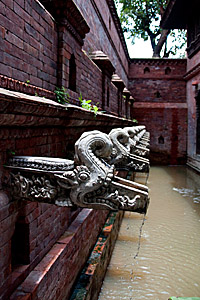
(Kathmandu, Bagmati, Nepal)
Monday, 20 July 2009Kathmandu, Bagmati, Nepal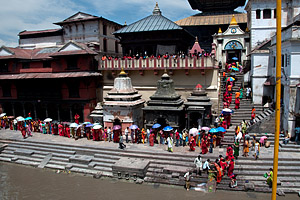 Pilgrims Queuing at Pashupatinath
Pilgrims Queuing at Pashupatinath
We had decided to spend the morning at Pashupatinath the oldest Hindu temple in Kathmandu and apparently the spot where Shiva, wanting to escape the other gods, escaped to from his palace on Mount Kailash. Fortunately it was a short walk from out hotel at a curve on the Bagmati river. As soon as we walked out of our hotel we were surrounded by hordes of people dressed in red and orange. We decided to go with the flow and were funnelled through a park along a path lined with stalls selling flowers and other dedications.
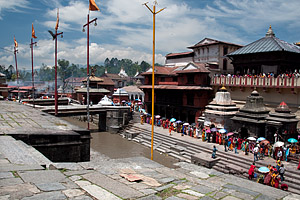 Ghats of Pashupatinath
Ghats of Pashupatinath(Kathmandu, Bagmati, Nepal)
Non Hindus were not allowed into the main shrine so, after paying an entrance fee, we skirted it and found ourselves by the banks of the river near the Ghats. Hindu custom is to cremate their relatives by the banks of a holy river washing the ashes away in the stream. We had seen people being taken for cremation before but never the funeral pyres themselves. When we arrived three pyres were already burning and a group of mourners were gathering around an unlit fourth. We walked up the river a bit and on the way back the family were just putting the body on the pyre. Whilst it seems a bit odd that we would watch, scores of people were gathered and watching much more intently. The eldest boy of the family lit the pyre but, not particularly wanting to see the process, we ducked out.
We headed for some terraces opposite the royal Ghats. It was here that King Birendra and Queen Aiswarya were cremated after they were massacred by their son in 2001 after he had been sent to bed for being drunk at a party. At this point however it was a much more joyous affair. Hundreds of worshippers, mostly women, lined the staircase waiting to get into the sanctuary. Another favourite pass time seemed to be trying to drop coins onto the top of a small shrine which held a statue of Shiva. On the terraces overlooking this spectacle we also encountered several Sadhus who were very keen to have their photos taken. Through sheer intolerance of tourist norms we did not bother here and at the many sites where they proliferated through Kathmandu.
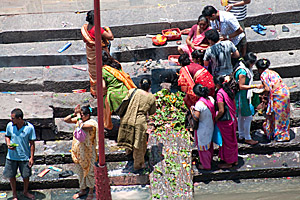 Devotions at Pashupatinath
Devotions at Pashupatinath(Kathmandu, Bagmati, Nepal)
After a bit we decided to walk over the hill to Golkinarth. We passed through a huge array of Shiva shrines and down the other side of the hill. There was not a lot to be seen here, apart from the spectacle of some sky diving monkeys which, for the great amusement of all around, were climbing trees and diving from some ten or twenty metres into a small pool. We then followed the river back and found ourselves once again at the terraces overlooking the ghats, from where we returned to the hotel.
Here we recuperated with a swim in the pool and an hour or so in the sun before heading out to central Kathmandu. We had a small list of optional extras which we had decided to buy there and had wanted to sample the central Durbar square, both these ideas turned out to be huge mistakes. Firstly there were a huge array of fake North Face jackets but the thermals I sought were nowhere to be found. As we headed further down Jaytha Thamel the shopping got more and more and more local and the streets very narrow. We reached a point where it was so crowded that we were almost going to turn back but then finally emerged into Indra Chowk.
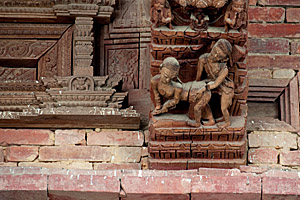 Temple Carvings in Durbar Square
Temple Carvings in Durbar Square(Kathmandu, Bagmati, Nepal)
Words cannot explain the streets of Thamel and what came afterwards in Durbar square. Imagine being hemmed in by a small alleyway six people wide with people rushing past you. Then add to this picture motorbikes, not just one or two, oh no, but a continual barrage of them trying to push past. In Durbar square, despite being more open this did not cease despite the fact that we had to pay a 200 Rs entry fee. In fact it was just supplemented with a never ending stream of "guides", saddhus and coin sellers all hanging on your every breath.
We woke up at 0530 and after a quick shower and a bit of breakfast headed to the airport. The time of our departure was not pre-ordained as it was governed by the cloud cover of our destination, Simikot , deep in a valley in the Himalayas. We turned up at the airport around 0700 and begun the slow process of check-in and security. This seemed to be purposefully staggered to ensure that Westerners did not get too bored with the wait however you got the impression that it would be side stepped if there was an early gap in the weather. We were not the only party, a group of four Germans and their Swiss/Nepali guide who had been on the plane to Nepalgunj were also being herded through the process.
To say the airport was rudimentary was an understatement, however Nepalgunj is a fairly rudimentary place. We sat in the departure lounge watching a bird flying around and sitting on the stand of a long disappeared TV set. Of course none of this helped to boost Anna's confidence and when the appointed hour arrived it proved very difficult to her onto the twin otter plane. This was to prove easy in comparison to what happened next, The plane took off okay but then after ten minutes of speeding over Nepal's steamy Southern Terai the pilot got some news which prompted him to turn around. It turned out that an earlier flight from Surket had been unable to land and at that point was circling above a cloud covered Simikot. We went back to Nepalgunj and again had a perfect landing.
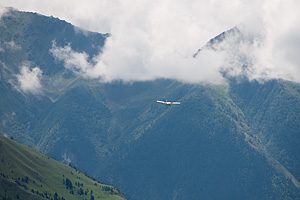 Plane Taking Off
Plane Taking Off(Simikot, Humla, Nepal)
I was devastated. Given the timings if we did not manage to get to Simikot that day there would be very little chance of us getting to Kailash by another route, hence ending our once in a life time trip. We unpacked the bags from the plane (yes we were doing this ourselves) and stood distraught on the edge of the tarmac. However it was at this point that we got some more news, the plane circling Simikot had landed and we were going to take off again. However this proved too much for Anna's nerves. No-one could explain what was happening at Simikot so it seemed like a very arbitrary set of decisions convincing her that we were heading towards a rocky grave.
However it turned out to be a spectacular trip, skimming over the tops of high mountain passes and crossing narrow valleys, some populated, some completely inaccessible. Whilst there was some clouds on the ridges the valleys were completely clear and as we approached Simikot we got our last surprise, a very steep descent followed by a landing on a dirt runway.
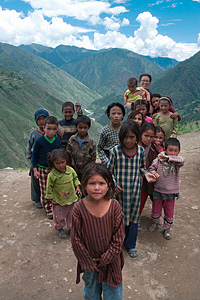 Local Children
Local Children(Simikot, Humla, Nepal)
Simikot is an idyllic spot, situated on a broad plateau 3000m up on a spur overlooking theKarnali River. It looked small but once we start walking around the village it became clear that it had a population of over a thousand making it a major metropolis. Crucially it has a tiny runway which cuts the town in two. The plane was unloaded quickly and we headed up to our hotel. The somewhat alarmingly named "Sun Valley Resort" turned out not to be a Casino but a couple of imposing stone and timber buildings. Our room was spartan with bare pine floorboards but spotlessly clean and had a terrific view out over the runway to the mountains.